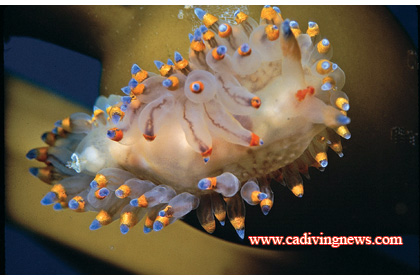If I were a poet I would surely pen an “Ode to Kelp.” California diving is both unique and fascinating due to our large beds of giant kelp. Kelp attracts, shelters and feeds much of California’s reef life. Many divers think of kelp that is something to be avoided, a barrier you must pass through to get to the reef below, an obstacle that needs to be circumvented as you make your way back to your boat or beach exit. However, the kelp itself supports a community of life that is unique and disparate from the reef below, and this community has a cornucopia of interesting and photogenic critters. A kelp plant is a complete studio for the underwater photographer. It offers a dazzling array of backgrounds, from amber kelp fronds, to blue water, to sunbursts, to jet-black. Unlike a rocky or coral reef, the three-dimensional nature of the kelp forest allows photographers almost complete freedom to select among various subjects and backgrounds.
First, giant kelp itself makes an interesting subject. The gas-filled bulbs and translucent amber fronds lend themselves to expressions of subtle shadows, hues and textures. If the swell or current is running, you may find it difficult to get the right composition. Some photographers get around this by attaching alligator or other clips to a sturdy frame of plastic pipe. The clips are used to hold the kelp in a well-defined and photogenic position.
Of course some of the more interesting images are of critters on kelp and not just the kelp itself. Each plant harbors an assortment of photogenic critters, if you have the eyes and patience to find them. Each kelp plant is its own ecosystem. Begin by carefully investigating a single kelp plant until you find something that interests you. Carefully look over each bulb, frond and stock, while thoroughly searching above, below and behind each.
There are numerous species of snails on kelp: blue-ring top and blue top snails. In Southern California you should look for Norris’s topsnail. These have florescent orange mantles that make for vibrant images when contrasted to the green kelp. There are also numerous species of crab, like the bright red kelp crab, and a great array of nudibranchs. Late in the summer the kelp takes on a fuzzy coating. This is composed of colonies of small animals called bryozoans. Not only do these make interesting macro subjects they are food to a great many animals. Some nudibranchs such as Janolus seek out kelp to feed on the bryozoan, Bugula.
Once you have found a likeable subject you have a huge variety of ways to compose your image. Because there is no hard bottom to get in the way of creative composition, you can position your subject, kelp, backgrounds and your camera with almost limitless degrees of freedom. If you shoot up, but not at the sun, you can have a blue background. If you shoot down a bit with a small aperture you can select a black background, or aim right at the sun for a sunburst. Try to get images where your subject’s eyes are visible, and they are either looking at the lens or at a 45 degree angle to the lens. Due to the three dimensional nature of kelp bulbs, it’s easy to get critters to appear to be crawling over the top of the bulb towards you.
Those who spend a bit of time exploring kelp will be rewarded with sights and images of fascinating critters. While we may not be poets, we can easily share the underwater world through our images.










